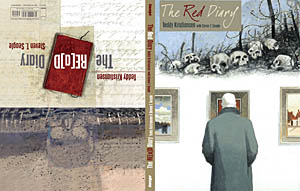 Written by Teddy Kristiansen and Steven T. Seagle
Written by Teddy Kristiansen and Steven T. Seagle
Art by Teddy Kristiansen
144 pages, color
Published by Image Comics
The Red Diary/The Re[a]d Diary is one of the strangest and most inventive graphic novels I’ve seen in a while, but it takes a little explaining. Teddy Kristiansen wrote and painted a graphic novel published in France titled Le Carnet Rouge (or The Red Diary). In bringing it to North America and an English translation, he came to his friend and often-collaborator Steven T. Seagle. He’s part of the Man of Action Studios collective, which has a deal with Image, but (as Seagle explains in the book) he needed to be a co-creator in order to publish it, and he wasn’t sure that just providing a translation would suffice.
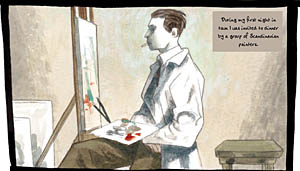 So, Seagle came up with an inventive plan. He’d take the French graphic novel and on his own write a brand-new script over top the art, trying to fit his script into the narration boxes and word balloons, and keeping in any names that didn’t require translation. Then, once he’d done that, he’d also (with the help of Kristiansen) script an actual translation of the graphic novel, and the two would be published side-by-side. The end result? The Red Diary, which contains Kristiansen’s original story, and The Re[a]d Diary, with Seagle’s brand new story "remixed" into Kristiansen’s art. It’s bizarre and off the wall, and yet? It utterly works.
So, Seagle came up with an inventive plan. He’d take the French graphic novel and on his own write a brand-new script over top the art, trying to fit his script into the narration boxes and word balloons, and keeping in any names that didn’t require translation. Then, once he’d done that, he’d also (with the help of Kristiansen) script an actual translation of the graphic novel, and the two would be published side-by-side. The end result? The Red Diary, which contains Kristiansen’s original story, and The Re[a]d Diary, with Seagle’s brand new story "remixed" into Kristiansen’s art. It’s bizarre and off the wall, and yet? It utterly works.
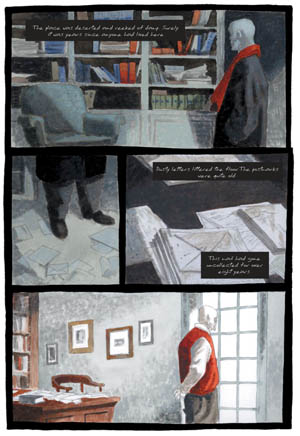 As heretical as it may sound, I must admit that of the two stories presented here it was Seagle’s that caught my attention more. There’s nothing necessarily wrong about Kristiansen’s own story from The Red Diary (and after all without it we’d have neither of these projects), but its plot involving a researcher finding diaries of an artist connected to a poet from World War I feels simultaneously a little too convoluted and also disengaging. The researcher himself has no real connection to the person whose story is being told; had the researcher only appeared in the first and last pages of The Red Diary that might not have been a problem, but the book dips back and forth between the two on a regular basis. It’s ultimately a dispassionate story, one where there aren’t any real stakes for the reader or one of the two main characters.
As heretical as it may sound, I must admit that of the two stories presented here it was Seagle’s that caught my attention more. There’s nothing necessarily wrong about Kristiansen’s own story from The Red Diary (and after all without it we’d have neither of these projects), but its plot involving a researcher finding diaries of an artist connected to a poet from World War I feels simultaneously a little too convoluted and also disengaging. The researcher himself has no real connection to the person whose story is being told; had the researcher only appeared in the first and last pages of The Red Diary that might not have been a problem, but the book dips back and forth between the two on a regular basis. It’s ultimately a dispassionate story, one where there aren’t any real stakes for the reader or one of the two main characters.
Seagle’s story, on the other hand, put the researcher character firmly into the center of the spotlight. It was a logical assumption for him to make upon seeing the art, that the character had a greater role in the book, and it works in The Re[a]d Diary. As you read along into a story that is also about art and the war, you get a much stronger sense of urgency and mystery bound into the exploration of the three color-coded diaries examined throughout the book. There’s a promised end goal here, a story about a character that needs to be told. And while Seagle provides a slight twist at the end of the book (although I suspect most readers will have guessed it long beforehand), it generally feels much more straight-forward and to the point. The Re[a]d Diary becomes a book that sets its sights on a specific ending and then arrives there.
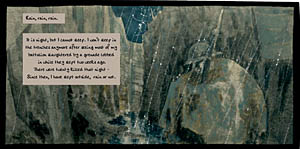 On the other hand, there’s no question as to the quality of the art for The Red Diary/The Re[a]d Diary, which is jaw-droppingly beautiful. Fully painted by Kristiansen, every page is carefully composed and would look amazing on display on your own wall. (For books about painters, this is of course an important thing to be able to pull off.) It’s also worth noting that each page is sequential enough that even though you lose the finer details without getting Kristiansen’s words, it’s still able to be followed as a story well enough that Seagle was able to create a story to overlay on top of the art.
On the other hand, there’s no question as to the quality of the art for The Red Diary/The Re[a]d Diary, which is jaw-droppingly beautiful. Fully painted by Kristiansen, every page is carefully composed and would look amazing on display on your own wall. (For books about painters, this is of course an important thing to be able to pull off.) It’s also worth noting that each page is sequential enough that even though you lose the finer details without getting Kristiansen’s words, it’s still able to be followed as a story well enough that Seagle was able to create a story to overlay on top of the art.
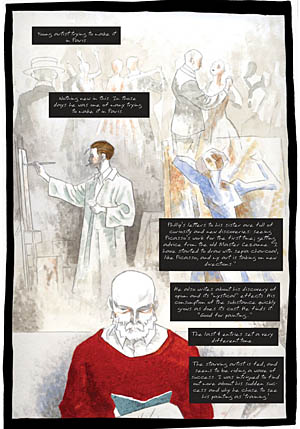 The pages with the narrator are the most peaceful ones; ones as simple as him walking through a library or gazing out the window have a level of quiet beauty about them. Nothing is left out; the walls are carefully painted just as much as the main character, and you can read into how characters are feeling through the body language displayed here. I also liked his usage of simple techniques to tell the story in an effective manner, like a montage of the past that has multiple images fading into one another. In both Kristiansen and Seagle’s story, it works as a way to get across both a specific event as well as a general feel to the time period, and his gentle and graceful lines mesh well with the painted colors.
The pages with the narrator are the most peaceful ones; ones as simple as him walking through a library or gazing out the window have a level of quiet beauty about them. Nothing is left out; the walls are carefully painted just as much as the main character, and you can read into how characters are feeling through the body language displayed here. I also liked his usage of simple techniques to tell the story in an effective manner, like a montage of the past that has multiple images fading into one another. In both Kristiansen and Seagle’s story, it works as a way to get across both a specific event as well as a general feel to the time period, and his gentle and graceful lines mesh well with the painted colors.
The war scenes are the most dramatic, of course. Here Kristiansen tosses out the lighter colors for dark greens and browns, a perfect choice for the infamous war of the trenches. There’s something in his color choices and heavy paints that can’t help but drag down the reader into the general despair of the moment. It’s beautifully rendered, and it gives those moments set in World War I an extra punch to the gut.
Could an experiment like The Red Diary/The Re[a]d Diary work again? Probably not. Re-dialoging comics has happened before and will again, of course, but there’s something about the utter mystery that confronted Seagle that makes this feel completely non-cynical and rather clever. I might have ended up liking The Re[a]d Diary half more, but I still appreciated what Kristiansen did for The Red Diary too. Add in the fact that this is published in a huge, over-sized flipbook that will let you examine the art for quite some time to come, and this is well worth your while.
Purchase Links: Amazon.com | Powell’s Books
